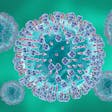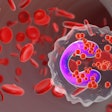
A recent sub-analysis of the international, prospective REALITI-A study has demonstrated the real-world effectiveness of mepolizumab in reducing exacerbations in patients with severe asthma characterized by an eosinophilic phenotype, even when coinciding with severe allergic asthma.
The study, “Mepolizumab Real-World Effectiveness in Severe Asthma With an Eosinophilic Phenotype and Overlapping Severe Allergic Asthma,” aimed to assess the efficacy of the anti-eosinophilic biologic drug in patients with severe asthma that have allergic and eosinophilic phenotypes. This overlap makes them eligible for both anti-eosinophilic and anti-IgE biologics. The study was published in the Annals of Allergy, Asthma & Immunology.
The study analyzed 822 patients with severe asthma and overlapping allergic and eosinophilic phenotypes, measuring the clinically significant asthma exacerbation (CSE) rate one year before and after mepolizumab treatment. Patients were stratified by baseline total IgE levels, atopic status, prior omalizumab use, geographic baseline omalizumab eligibility and combinations of baseline IgE levels and blood eosinophil counts.
Key findings from the study include:
- Reduction in exacerbations: The CSE rate was significantly reduced during the follow-up period across all subgroups. Before treatment, 93% of patients experienced CSEs, which dropped to 49% during follow-up.
- Effectiveness across subgroups: The reduction in CSE rate was consistent across various baseline IgE levels, atopic statuses, prior omalizumab use and eligibility criteria. For example, patients with baseline IgE levels less than 60 kU/L saw a reduction in CSE rate to 0.31, while those with levels greater than 550 kU/L saw a reduction to 0.28.
- Combination of IgE and eosinophil counts: The study also found that the CSE rate was reduced across all combinations of baseline IgE levels and blood eosinophil counts, further confirming the broad effectiveness of mepolizumab.
Researchers said the study supported the use of mepolizumab as a valuable treatment option for this patient population.






















